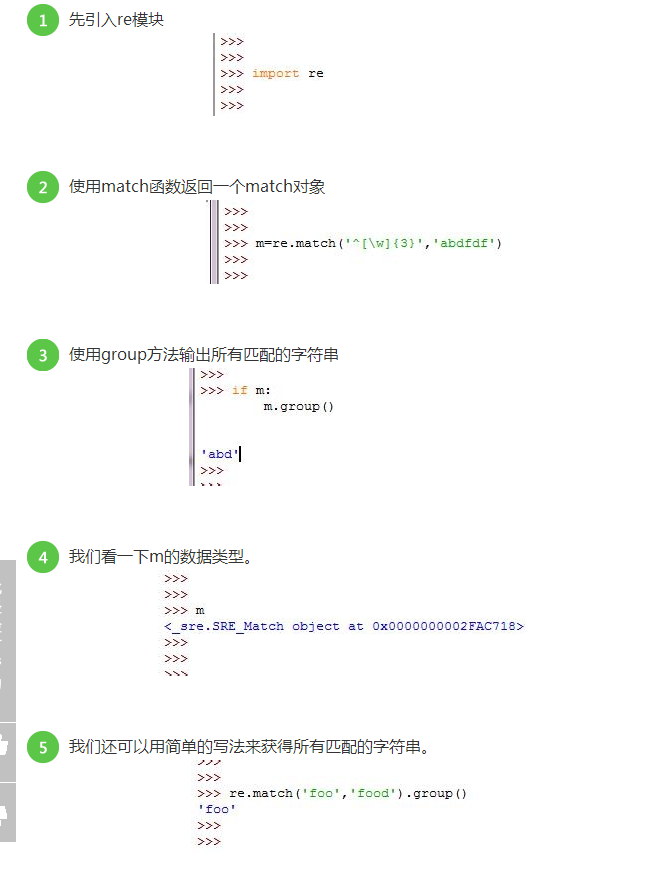match()和search()都是python中的正则匹配函数,那这两个函数有何区别呢?
match()函数只检测RE是不是在string的开始位置匹配, search()会扫描整个string查找匹配, 也就是说match()只有在0位置匹配成功的话才有返回,如果不是开始位置匹配成功的话,match()就返回none
例如:
?
|
1
2
3
4
5
6
7
8
9
|
#! /usr/bin/env python
# -*- coding=utf-8 -*-
import re
text = 'pythontab'
m = re.match(r"\\w+", text)
if m:
print m.group(0)
else:
print 'not match'
|
结果是:pythontab
而:
?
|
1
2
3
4
5
6
7
8
9
10
|
#! /usr/bin/env python
# -*- coding=utf-8 -*-
#
import re
text = '@pythontab'
m = re.match(r"\\w+", text)
if m:
print m.group(0)
else:
print 'not match'
|
结果是:not match
search()会扫描整个字符串并返回第一个成功的匹配
例如:
?
|
1
2
3
4
5
6
7
8
9
10
|
#! /usr/bin/env python
# -*- coding=utf-8 -*-
#
import re
text = 'pythontab'
m = re.search(r"\\w+", text)
if m:
print m.group(0)
else:
print 'not match'
|
结果是:pythontab
那这样呢:
?
|
1
2
3
4
5
6
7
8
9
10
|
#! /usr/bin/env python
# -*- coding=utf-8 -*-
#
import re
text = '@pythontab'
m = re.search(r"\\w+", text)
if m:
print m.group(0)
else:
print 'not match'
|
结果是:pythontab
总结:
如果不创建pattern对象,我们使用match函数可以直接进行正则表达式的匹配,在我看来这种方式更简洁,不过不适合大型程序的编写,后期维护可能会产生困难,不过编写一些小脚本完全可以胜任。
search函数和match函数有点类似,都可以匹配模式,但是match和search函数也有区别,而且区别很大,match函数只能够字符串的开始位置开始匹配,而search是可以匹配字符串的任意位置,但也是返回找到的第一个匹配的模式。我们通过例子来了解这俩之间的区别吧。
相关文章
猜你喜欢
- ASP.NET本地开发时常见的配置错误及解决方法? 2025-06-10
- ASP.NET自助建站系统的数据库备份与恢复操作指南 2025-06-10
- 个人网站服务器域名解析设置指南:从购买到绑定全流程 2025-06-10
- 个人网站搭建:如何挑选具有弹性扩展能力的服务器? 2025-06-10
- 个人服务器网站搭建:如何选择适合自己的建站程序或框架? 2025-06-10
TA的动态
- 2025-07-10 怎样使用阿里云的安全工具进行服务器漏洞扫描和修复?
- 2025-07-10 怎样使用命令行工具优化Linux云服务器的Ping性能?
- 2025-07-10 怎样使用Xshell连接华为云服务器,实现高效远程管理?
- 2025-07-10 怎样利用云服务器D盘搭建稳定、高效的网站托管环境?
- 2025-07-10 怎样使用阿里云的安全组功能来增强服务器防火墙的安全性?
快网idc优惠网
QQ交流群
您的支持,是我们最大的动力!
热门文章
-
Java中利用Alibaba开源技术EasyExcel来操作Excel表的示例代码
2025-05-29 33 -
2025-05-25 59
-
2025-05-27 26
-
选择稳定的网站服务器租用时,带宽和流量限制如何影响网站速度?
2025-05-27 102 -
2025-05-25 90
热门评论














